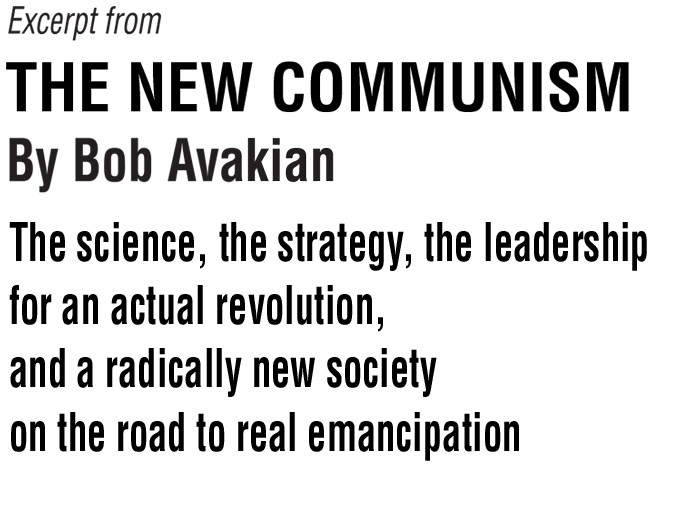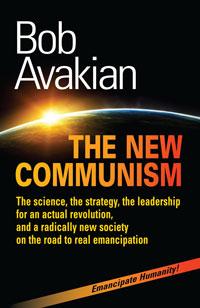
The following is an excerpt from the work by Bob Avakian, The New Communism. In addition to this and other excerpts posted on revcom.us, we will be running further excerpts from time to time on revcom.us. These excerpts should serve as encouragement and inspiration for people to get into the work as a whole, which is available as a book from Insight Press and as a PDF online at revcom.us.


This excerpt comes from the section titled “III. The Strategic Approach to An Actual Revolution”
The “5 Stops”
Here I want to talk about the “5 Stops” that appear regularly now on the revcom.us website. This is not just, “Oh, here are five good things to talk about, or five things that are wrong in society,” in some general sense. This is a strategic formulation. If you go back to “Some Principles for Building A Movement for Revolution,” these “5 Stops” represent concentrations of major social contradictions; and they are contradictions which are not resolvable under this system. Think about this: The genocidal persecution of Black and Brown people, police brutality and murder and mass incarceration; the oppression of women, and oppression based on gender and sexual orientation; what’s happening to the environment; the hounding and terrorizing of immigrants; and the wars of occupation and crimes against humanity being carried out under the domination of this system—all these are major concentrations of social contradictions, contradictions which are not resolvable under this system, certainly not in a way that would be in the interests of the masses of people, or ultimately humanity as a whole. So that’s the point: They represent concentrations of major social contradictions, and they are contradictions that this system cannot resolve in the interests of the masses of people—both things are very important, they have strategic implications. It’s not just, “Oh, they’re concentrations of social contradictions—isn’t that interesting?” But because they are, and as a reflection of the fact that they are, concentrations of major social contradictions, they speak to what a lot of people are concerned about in one way or another, or to one degree or another. Not everybody is concerned about all 5 of them, but probably everybody is concerned about at least one of them, and some people are probably concerned about all of them. (It’s kind of like that Lincoln statement—or was it Bob Dylan?: You can fool some of the people all of the time; you can fool all of the people some of the time; but you can’t fool all of the people all of the time. Sorry, I couldn’t resist that detour!) Anyway, this is the point: These “5 Stops” speak to things that, in one way or another, to one degree or another, people are concerned about, because they are concentrations of major social contradictions.
Way back in the days of the RU (Revolutionary Union), we used to have this formulation: develop fighters on one front into fighters on all fronts. And we should go further and say: strategically develop them into fighters for the whole thing. But there is an important point to this: People get drawn into motion by their concern about one thing or another, but people are not closed-minded—everybody’s not closed-minded and narrow-minded. Many people don’t say, “Oh, this is my issue, I don’t care about that other stuff”—not everybody thinks like that, even though some opportunists do. In fact, a lot of people don’t think like that. As they learn about other things, many people get interested, they develop a broader vision, as they come in contact with people who bring this to them. This is an important part of why I have been giving emphasis to Lenin’s point about going among all sections of the people. There is the “apartheidization” of this society, but we can’t accept that. We have to knock that down. We have to send parents whose kids have been killed by the police onto the college campuses to talk to students: “This is the reality of what goes on out here.” It’s not that most students, when they hear about that, don’t care. But right now, for the most part, they don’t know anything about it. And, look, I hate to say it, but a lot of them have had their thinking conditioned not only by the ruling class in a general sense, but also by other people. I’m sorry, but since the 1980s, there have been more than a few Reaganites running around among the basic masses, people whose outlook is very similar to Ronald Reagan, in terms of an overwhelming focus on just getting rich, in ruthless competition with other people. You see it in hip-hop—“get rich or die trying”—all this kind of crap. Now, of course, that is not all there is to hip-hop; but that kind of culture has been promoted by the ruling class, because it serves their interests. And it’s had an effect, not just on the basic masses, but on a lot of these middle strata people: their view of the basic masses is, to a significant degree, influenced by and filtered through that culture. They don’t know the basic people, but what they know, or think they know, is filtered through that culture. So this is something we have to combat, bringing to people an understanding of the actual relations in society and how this affects people.
We have to go among all sections of the people. Through work and struggle with people, we have to enable them to develop from people concerned about, and fighting on, one front into fighters on all fronts—and, fundamentally, fighters for the whole thing, to get rid of this, all these “5 Stops,” and everything that’s concentrated there in terms of the whole system which gives rise to this repeatedly, spews it forth like a sewer backing up.
So this has strategic importance, these “5 Stops.” People should understand how this relates to our strategic orientation of United Front under the Leadership of the Proletariat, because it’s not just a question of different interest groups: “Oh, you are interested in this, and you over there are interested in that, and somehow we can sort of add that all up”—“intersectionalism” that will somehow add up to a proletarian revolution. No. There needs to be the solid core running through all this. But these “5 Stops” are areas of concern for people and, if you want to use a somewhat homely phrase (or metaphor), they are on-ramps for people to get involved with the struggle, and to connect with people who are concerned about many different things, as well as people who are concerned about the whole thing. I’m not sure to what degree these “5 Stops” have really been understood in the way they should be. Why is it we keep having them on the website so prominently? People should think about that: What are the strategic implications of that?
Contents
Publisher's Note
Introduction and Orientation
Foolish Victims of Deceit, and Self-Deceit
Part I. Method and Approach, Communism as a Science
Materialism vs. Idealism
Dialectical Materialism
Through Which Mode of Production
The Basic Contradictions and Dynamics of Capitalism
The New Synthesis of Communism
The Basis for Revolution
Epistemology and Morality, Objective Truth and Relativist Nonsense
Self and a “Consumerist” Approach to Ideas
What Is Your Life Going to Be About?—Raising People’s SightsPart II. Socialism and the Advance to Communism:
A Radically Different Way the World Could Be, A Road to Real EmancipationThe “4 Alls”
Beyond the Narrow Horizon of Bourgeois Right
Socialism as an Economic System and a Political System—And a Transition to Communism
Internationalism
Abundance, Revolution, and the Advance to Communism—A Dialectical Materialist Understanding
The Importance of the “Parachute Point”—Even Now, and Even More With An Actual Revolution
The Constitution for the New Socialist Republic in North America—
Solid Core with a Lot of Elasticity on the Basis of the Solid Core
Emancipators of HumanityPart III. The Strategic Approach to An Actual Revolution
One Overall Strategic Approach
Hastening While Awaiting
Forces For Revolution
Separation of the Communist Movement from the Labor Movement, Driving Forces for Revolution
National Liberation and Proletarian Revolution
The Strategic Importance of the Struggle for the Emancipation of Women
The United Front under the Leadership of the Proletariat
Youth, Students and the Intelligentsia
Struggling Against Petit Bourgeois Modes of Thinking, While Maintaining the Correct Strategic Orientation
The “Two Maximizings”
The “5 Stops”
The Two Mainstays
Returning to "On the Possibility of Revolution"
Internationalism—Revolutionary Defeatism
Internationalism and an International Dimension
Internationalism—Bringing Forward Another Way
Popularizing the Strategy
Fundamental OrientationPart IV. The Leadership We Need
The Decisive Role of Leadership
A Leading Core of Intellectuals—and the Contradictions Bound Up with This
Another Kind of “Pyramid”
The Cultural Revolution Within the RCP
The Need for Communists to Be Communists
A Fundamentally Antagonistic Relation—and the Crucial Implications of That
Strengthening the Party—Qualitatively as well as Quantitatively
Forms of Revolutionary Organization, and the “Ohio”
Statesmen, and Strategic Commanders
Methods of Leadership, the Science and the “Art” of Leadership
Working Back from “On the Possibility”—
Another Application of “Solid Core with a Lot of Elasticity on the Basis of the Solid Core”Appendix 1:
The New Synthesis of Communism:
Fundamental Orientation, Method and Approach,
and Core Elements—An Outline
by Bob AvakianAppendix 2:
Framework and Guidelines for Study and DiscussionNotes
Selected List of Works Cited
About the Author